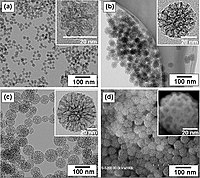
Photo from wikipedia
Nanoparticle assemblies have generated intense interest due to their novel optical, electronic, and magnetic properties which open up numerous opportunities in fundamental and applied nanophotonics, -electronics, and -magnetics. However, despite… Click to show full abstract
Nanoparticle assemblies have generated intense interest due to their novel optical, electronic, and magnetic properties which open up numerous opportunities in fundamental and applied nanophotonics, -electronics, and -magnetics. However, despite the great scientific and technological potential of these structures, it remains an outstanding challenge to reliably fabricate such assemblies with both nanometer-level structural control and precise spatial arrangements on a macroscopic scale. It is the combination of these two features which is key to realizing nanoparticle assemblies' potential, particular for device applications. To address this issue, we propose a hierarchical assembly approach consisting of both template-particle and particle-particle interactions, whereby the former ensures precise addressability of assemblies on a surface and the latter provides nanometer-level structural control. Template-particle interactions are harnessed via chemical pattern directed assembly, and the particle-particle interactions are controlled using DNA directed self-assembly. To demonstrate the potential of this hierarchical assembly approach, we demonstrate the fabrication of a particularly fascinating assembly: the nanoparticle heterodimer, which possesses a surprisingly rich set of plasmonic properties and is a promising candidate to enable a variety of imaging and sensing applications. Each heterodimer is placed on the surface at pre-determined locations, and the precise control of the nanogaps is confirmed by far-field scattering measurements of individual dimers. We further demonstrate that the gap size can be effectively tuned by varying the DNA length. By correlating measured spectra with finite-difference time-domain (FDTD) simulations, we determine the gap sizes to be 4.2 nm and 5.0 nm-with sub-nm deviation-for the two DNA lengths investigated, one of the best gap uniformities ever demonstrated for surface-bound nanoparticle assemblies. The estimated surface-enhanced Raman scattering (SERS) enhancement factor of these heterodimers is on the order of 105-106 with high reproducibility and predictable polarization-dependence. This hierarchical fabrication technique-employing both template-particle and particle-particle interactions-constitutes a novel platform for the realization of functional nanoparticle assemblies on surfaces, and thereby creates new opportunities to implement these structures in various applications.
Journal Title: Nano letters
Year Published: 2019
Link to full text (if available)
Share on Social Media: Sign Up to like & get
recommendations!